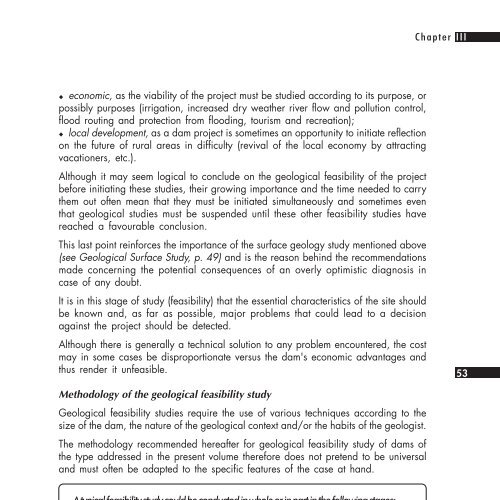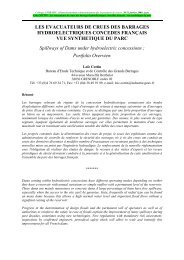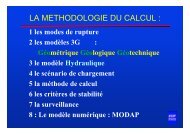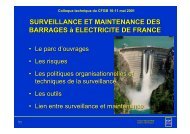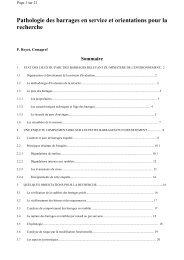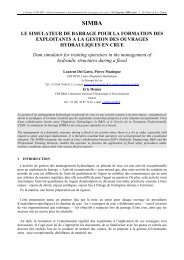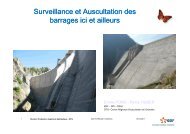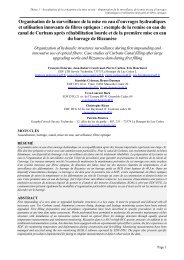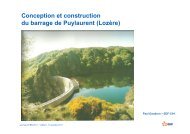SMALL DAMS
SMALL DAMS - Comité Français des Barrages et Réservoirs
SMALL DAMS - Comité Français des Barrages et Réservoirs
- No tags were found...
You also want an ePaper? Increase the reach of your titles
YUMPU automatically turns print PDFs into web optimized ePapers that Google loves.
Chapter III<br />
!"economic, as the viability of the project must be studied according to its purpose, or<br />
possibly purposes (irrigation, increased dry weather river flow and pollution control,<br />
flood routing and protection from flooding, tourism and recreation);<br />
!"local development, as a dam project is sometimes an opportunity to initiate reflection<br />
on the future of rural areas in difficulty (revival of the local economy by attracting<br />
vacationers, etc.).<br />
Although it may seem logical to conclude on the geological feasibility of the project<br />
before initiating these studies, their growing importance and the time needed to carry<br />
them out often mean that they must be initiated simultaneously and sometimes even<br />
that geological studies must be suspended until these other feasibility studies have<br />
reached a favourable conclusion.<br />
This last point reinforces the importance of the surface geology study mentioned above<br />
(see Geological Surface Study, p. 49) and is the reason behind the recommendations<br />
made concerning the potential consequences of an overly optimistic diagnosis in<br />
case of any doubt.<br />
It is in this stage of study (feasibility) that the essential characteristics of the site should<br />
be known and, as far as possible, major problems that could lead to a decision<br />
against the project should be detected.<br />
Although there is generally a technical solution to any problem encountered, the cost<br />
may in some cases be disproportionate versus the dam's economic advantages and<br />
thus render it unfeasible.<br />
53<br />
Methodology of the geological feasibility study<br />
Geological feasibility studies require the use of various techniques according to the<br />
size of the dam, the nature of the geological context and/or the habits of the geologist.<br />
The methodology recommended hereafter for geological feasibility study of dams of<br />
the type addressed in the present volume therefore does not pretend to be universal<br />
and must often be adapted to the specific features of the case at hand.<br />
A typical feasibility study could be conducted in whole or in part in the following stages:<br />
STAGE 1: Desk study<br />
For any dam, even the smallest, it is of great interest to consult existing geological<br />
maps and the accompanying documentation. For dams about twenty metres<br />
high or more, it can be of interest to search within regional geological literature<br />
(articles in specialised journals, theses, monographs, notes to geological maps)<br />
for any previous studies done on the region of the site under study or simply<br />
mentions of details that could be useful in understanding the context and the<br />
geological history of the area (location and description of outcroppings, of fossilbearing<br />
formations, borrow areas for various useable materials, particular structures,<br />
cavities, springs or watershed leakage, etc.).<br />
...


